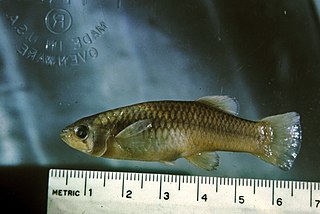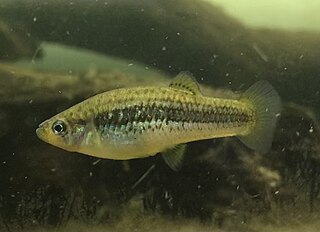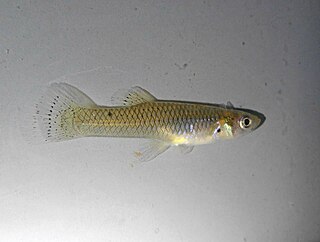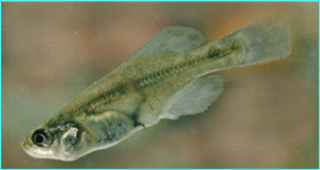
Gambusia is a large genus of viviparous fish in the family Poeciliidae. Gambusia contains over 40 species, most of which are principally found in freshwater habitats, though some species may also be found in brackish or saltwater habitats. The genus Gambusia comes from the Cuban term, "Gambusino", which means "free-lance miner". The type species is the Cuban gambusia, G. punctata. The greatest species richness is in Mexico, Texas, and the Greater Antilles, but species are also found elsewhere in the eastern and southern United States, the Bahamas, Central America, and Colombia. Gambusia species are often called topminnows, or simply gambusias; they are also known as mosquitofish, which, however, refers more specifically to two species, G. affinis and G. holbrooki, which are often introduced into ponds to eat mosquito larvae. As a consequence, they have been introduced widely outside their native range, and frequently become invasive, threatening local species. G. affinis and G. holbrooki are now established in many parts of the world and are likely to continue to spread as climatic conditions change. They are only occasionally kept in aquariums, due to their relative lack of color and the highly aggressive nature of the aforementioned mosquitofish species.

Characodon is a genus of splitfins endemic to north–central Mexico. Two of the species are highly threatened and restricted to pools, ponds and springs in the upper San Pedro Mezquital River basin in Durango. The third species, C. garmani, was restricted to springs near Parras in Coahuila, but it became extinct when they dried out.
The mesh-scaled topminnow is a species of fish in the family Poeciliidae. The two population groups are a southern group of populations found in Angola, Botswana, the Republic of the Congo, Malawi, Mozambique, and Zambia and a northern population group found in Chad, the Central African Republic, the White Nile in South Sudan and Sudan and in the northern Democratic Republic of Congo. Its natural habitat is small streams and brooks, lakes, and swamps on floodplains where it lives among aquatic vegetation. This species was described by George Albert Boulenger as Haplochilus hutereaui in 1913 with the type locality being Dungu on the upper Uelé River in the Democratic Republic of Congo. Boulenger received the type from Armand Hutereau (1875-1914), who was the head of a Belgian ethnographic expedition to the Congo, so he honoured Hutereau in the specific name.
The yellowfin gambusia is a species of fish in the family Poeciliidae. It is endemic to the Rio Conchos of Chihuahua, Mexico, where it is known as guayacon de san gregorio. This species was described in 1957 by Clark Hubbs and Victor G. Springer with the type locality given as El Ojo de San Gregorio in Chihuahua. The specific name of this fish honours the Mexican ichthyologist José Alvarez del Villar (1903-1986) for his work on the fishes of Mexico and for his assistance to Clark and Springer.

The Big Bend gambusia is a rare species of fish in the family Poeciliidae. It is endemic to the Big Bend region of the Rio Grande of the United States and Mexico. The only known remaining population is in a protected pond in the Big Bend National Park.

Gambusia hurtadoi, also known as crescent gambusia, is a species of fish in the family Poeciliidae. It is endemic to Chihuahua in Mexico, where it is known as guayacon de Hacienda Dolores. It grows to 3.5 cm (1.4 in) total length. The species was described in 1957 by Carl Leavitt Hubbs and Victor G. Springer with the type locality given as El Ojo de la Hacienda Dolores, 7 miles south of Jiminez, Chihuahua, the spring to which this species is endemic. Hubbs and Springer honoured the Mexican Leopoldo Hurtado Olin of the Departamento de Economía in Chihuahua for his assistance during their collecting expedition to Chihuahua in June 1951. Hurtado Olin also informed Hubbs and Springer of the location of El Ojo de la Hacienda Dolores.

Gambusia speciosa, the Tex-Mex gambusia, is a species of fish in the family Poeciliidae which is found in the United States and Mexico. In Mexico its range covers the states of Chihuahua, Coahuila, Nuevo León and Tamaulipas while in the United States it is found in New Mexico and Texas. In Texas it is restricted to the Devils River and its tributaries in Val Verde County. The habitat of the Tex-Mex gambusia includes springs, outflow channels, marshes and the margins of small to medium-sized streams. This species was described by Charles Frédéric Girard in 1859 with the type locality given as the Río San Diego, near Cadereita in Nuevo León.

The Chapultepec splitfin, known locally as mexcalpique, is a critically endangered species of fish in the family Goodeidae. It is endemic to Mexico and was originally restricted to lakes and wetlands in the Valley of Mexico, including Lake Texcoco. Through man-made channels it was able to spread to the upper Pánuco River basin. Most native populations disappeared as they were at or near Mexico City, with the waters either being reclaimed, drained, heavily polluted or infested with introduced species. Today the Chapultepec splitfin is only known to survive in three lakes in the Chapultepec park of Mexico City, Lake Xochimilco, Lake Zumpango, Laguna de Tecocomulco northeast of the City where perhaps introduced, and parts of the Pánuco River basin. Most of these remaining populations are small. This species was originally described as Cyprinus viviparus in 1837 by Miguel Bustamante y Septién with the type locality given as "Mexico". In 1860 Pieter Bleeker raised the genus Girardinichthys with a new species Girardinichthys viviparus as its type species, this subsequently proved to be a taxonomy of Cyprinus viviparus.

The Highland splitfin is a species of splitfin endemic to Mexico where it is found in the Lerma River basin. This species grows to a length of 5 centimetres (2.0 in) TL. It is the only known member of its genus, although some authorities have Hubbina as a subgenus of Girardinichthys and add Girardinichthys ireneae to the subgenus, even treating this taxon as a synonym of G. ireneae. This species was described by Don Fernando de Buen y Lozano in 1940 with the type locality given as Cointzio, Michoacán. The name of the genus honours the American ichthyologist Carl Leavitt Hubbs (1894-1979) while the specific name honours Clarence Lester Turner (1890-1969), thus honouring two ichthyologists who worked on a review of the Goodeidae in 1939.
The eastcoast lampeye is a species of fish in the family Poeciliidae. It is endemic to coastal Kenya and Tanzania, where found in brackish water, mangrove swamps, pools, lagoons and river deltas. It reaches up to 5 cm (2.0 in) in total length. This fish was described by Ernst Ahl as Haplochilichthys stuhlmanni with the type locality given as Tanganyika Territory. The specific name honours the co-leader of the German East Africa Expedition (1889-1892) on which type was collected, Franz Ludwig Stuhlmann (1863-1928) of the German Colonial Service.

Heterandria is a genus of livebearing fishes within the family Poeciliidae. Most species occur in Guatemala and its surroundings, particularly Mexico, but the midget livebearer (H. formosa) comes from the southeastern United States.

The green swordtail is a species of freshwater/brackish fish in family Poeciliidae of order Cyprinodontiformes. A live-bearer, it is closely related to the southern platyfish or 'platy' (X. maculatus) and can crossbreed with it. It is native to an area of North and Central America stretching from Veracruz, Mexico, to northwestern Honduras.
Foerschichthys flavipinnis is a species of fish in the family Nothobranchiidae native to the western African nations of Ghana, Togo, Benin and Nigeria. This species grows to a length of 3.5 centimetres (1.4 in) TL. It is the only known member of its genus. This species was described by Herman Meinken as Aplocheilichthys flavipinnis in 1932 with the type locality given as being near Lagos in Nigeria.
Carlhubbsia is a genus of poeciliids native to Guatemala and Mexico. The name of this genus honours the American ichthyologist Carl Leavitt Hubbs (1894-1979) who originally named the genus Allophallus, a name which was preoccupied by a genus of Diptera.
Membras martinica, the rough silverside, is a species of Neotropical silverside from the family Atherinopsidae, it is the type species of the genus Membras.

Andamia expansa is a species of combtooth blenny which is known from a few specimens from the eastern Indian Ocean, with the type being collected in the Andaman Islands. The IUCN rate it as Data Deficient because its taxonomy is unclear. It forms pairs and lays adhesive eggs on the substrates.

The Nile killifish, also known as the Nile lampeye, is a species of killifish from the family Poeciliidae. It is found in the White Nile drainage in Sudan, the Nile Delta in Egypt, the Wembere and Malagarasi Rivers in Tanzania and in the Lake Victoria basin in Uganda and Tanzania. However, it is thought to have been extirpated from Egypt, the introduction of alien poecilid fish, agricultural pollution and increasing salinity are all thought to have contributed to its local extinction in the Nile Delta.

The licorice gourami is a species of freshwater ray-finned fish from the subfamily Macropodusinae, part of the family Osphronemidae, the gouramis. It is endemic to Bangka in Indonesia where it is found in the slow, flowing streams with black waters associated with peat swamp forests. This species was formally described by the Dutch ichthyologist Pieter Bleeker as Osphromenus deissneri in 1859 with the type locality given as Sungai Baturussa basin at 8 kilometres from Pudingbesar on the road to Kampong Simpan, Bangka. It is the type species of the genus Parosphromenus. The specific name honours F. H. Deissner, a military health officer, who sent a collection of specimens of fishes from Bangka to Bleeker which included the type of this species.

The iris wrasse(Lapanella fasciata) is a species of marine ray-finned fish from the family Labridae, the wrasses. It is found in the eastern Atlantic Ocean from Portugal to Morocco, as well as Madeira and the Azores, and in the Mediterranean Sea as far east as the Adriatic Sea. It lives in deep, rock areas where it feeds on crabs, molluscs and polychaete worms.

The school bass is a species of marine ray-finned fish, it is the only member of the monotypic genus Schultzea which is part of the subfamily Serraninae which itself is classified within the family Serranidae, along with the anthias and groupers. It is found in the western central Atlantic Ocean. This species is found in deeper waters near coral reefswhere it forms small groups which feed on plankton. The school bass is a synchronous hermaphrodite. The generic name honours the American ichthyologist Leonard Peter Schultz (1901-1986) who was Curator of Fishes at the United States National Museum who examined the specimens described by Loren P. Woods (1914-1979) as Schultzea campachanus, which was later shown to be a synonym of Hildebrand's Serranus beta.














